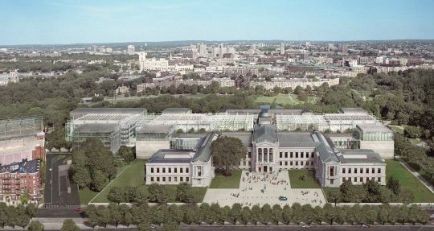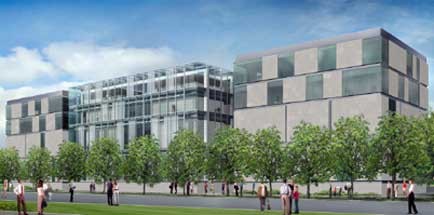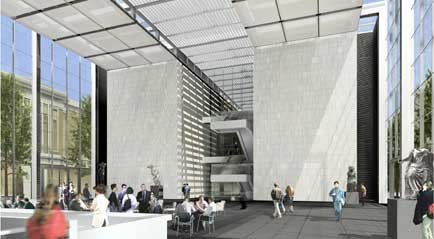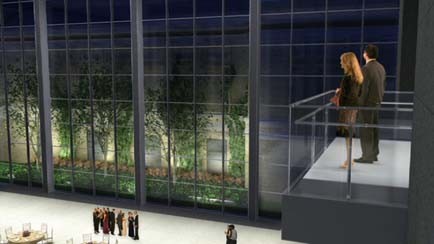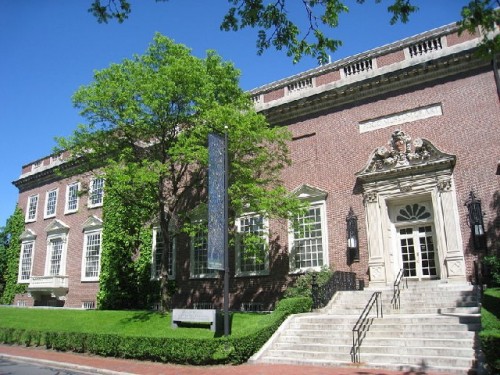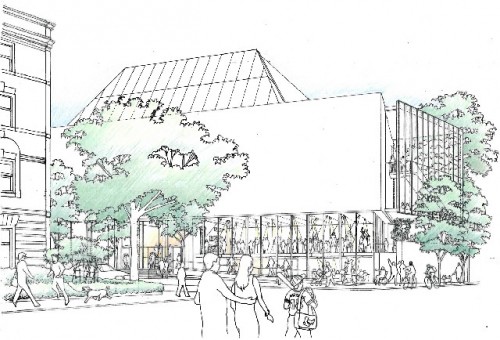Massachusetts Museums Expand and Renovate
Star Architects Designing Institutional Images Part II
By: Mark Favermann - Aug 03, 2008
Two of the largest and most prestigious institutions in Massachusetts and even the world are now in the throes of museum expansion and renovation: The Boston Museum of Fine Arts (MFA) and Harvard University's Art Museums (HUAM). Though not far apart geographically, they are leagues apart in terms of community and urban design issues and problems.
On June 20, 2008, the venerable Boston Museum of Fine Arts (MFA) reopened the doors of the State Street Corporation Fenway Entrance. This renovation work is part of the overall plan by London-based Pritzker Prize-winning architect Baron Norman Foster's Foster and Partners. Now, once again, the MFA's entrance faces the verdant Fens of the Fenway.
The renovation of this handsome entrance, which originally opened in 1915 and has been closed since the late 1970s marks a milestone in the MFA's Building Project, re-establishing the building's north-south axis as originally designed by architect Guy Lowell at the beginning of the 20th Century. A number of improvements also have been added including new streetlamps, accessible ramps flanking the Fenway Entrance stairs and colonnade, a brightened façade at night with improved lighting, new landscaping with sculpture, and a pair of reflecting pools with fountains.
In May 1999, the MFA commissioned the internationally renowned architectural firm Foster and Partners to develop a comprehensive Master Site Plan for the Museum. Along with better wayfinding and a more central location for a state of the art Sharf Visitor Center, the Building Project will feature a spectacular new wing for Art of the Americas, renovated Art of Europe galleries, generous new space for Contemporary Art, redesigned and expanded Museum Learning facilities, a Glass Courtyard for use year-round, and a new Gund Gallery for special and temporary exhibitions. In addition, the expansion will provide larger, state-of-the-art Conservation facilities and significantly improved visitor services and amenities. The entire MFA expansion and renovation is scheduled for completion in 2010 or 2011.
Work has begun on the Huntington Avenue Entrance to install access ramps and a new lobby and ticketing area as well. Once both main MFA entrances are open in 2009, the West Wing entrance will close to the public and will be used only for visiting school groups and Museum staff. Both of the surface parking lots on the Museum's west side will be reconfigured for public and school bus parking. Museum Road will become a two-way street, with parking on both sides.
Traffic will be able to exit the west-side parking lots in either direction to Huntington Avenue or to the Fenway. This will save drivers from circumnavigating the museum as they leave heading west. Interesting, there has been little if any community or neighborhood opposition to any of the MFA's plans. This is probably due to its institutional setting along Huntington Avenue with other cultural entities and colleges and universities and the lack of a strong or even politically involved nearby resident group to challenge any of their plans.
From Beijing to Boston, Foster and Partners is a massive architectural firm involved in major projects all over the world. The architectural firm is steeped in innovative technology and cutting-edge creatively geometric design and has created London's knife-like Millennium Bridge (1999/2002), London's modified sphere New City Hall (2002) and the phallic Gherkin (the Swiss Re Building in 2004) among many others. Foster is known for his personal involvement in all of his projects details. Someone once said God is in the details. Foster certainly believes this. If the architects complete the expansion and renovations of the MFA as well as they created The Great Court of the British Museum with its new tessellated roof arching around the original, circular, Reading Room of the once British Library, then we will have something quite spectacular and magnificent at the MFA.
The Foster plans for the MFA promise to completely re-orient the visitor to the museum. This project will further establish the MFA as one of the great museums of the world in the 21st Century in terms of visitor circulation, quality amenities and art interaction. Grand spaces will underscore the great art at the MFA.
The Harvard Art Museum's historic building at 32 Quincy Street, Cambridge, Massachusetts, the home of the Fogg Museum and Busch-Reisinger Museum closed on June 30, 2008 for a major renovation and expansion. This major project is being designed by renowned architect Renzo Piano. The 32 Quincy Street project is scheduled to be completed in 2013 and will unite all three (including the Arthur M. Sackler Museum) of the Harvard University art museums in one state-of-the-art facility. The Harvard Art Museum's collection is considered to be the greatest art collection owned by a university in the world. It is one of the greatest collections in the world anywhere.
Form follows function here, or at least a bit of disfunction. The need for the renovation is driven by some serious structural problems of the building that put the Art Museum's collection at risk, including: leaking roofs, old plumbing, antiquated electrical systems, the lack of proper climate control, considerable structural deterioration as well as the frequent failings of other out-dated building systems that needed to be replaced. In other words, the Fogg was a mess. The renovation is about 50 years badly over-due.
Though virtually under one roof, each of the museums will retain its own distinct identity. There will be larger exhibition galleries as well as a dedicated study center. Architect Renzo Piano's renovated and expanded facility will feature an array of new visitor amenities. These will offer greatly enhanced flexibility for viewing, studying, and interacting with the collections. The goal of the Harvard Art Museum's project is to provide a dynamic museum experience for visitors and to establish an innovative new model for object-based learning. Construction is scheduled to begin in 2009, and the renovated building will open in 2013.
This major project has taken place in the context or at least an atmosphere of community activism, large-scale development, major campus planning and on-again off-again projects in Cambridge and Allston neighborhoods. Cambridge Riverside Neighborhood residents successfully shot down an effort to develop an art museum site along the Charles River on memorial Drive in 2002. Apparently, the crowd that would come to visit the facility would have been disruptive to the neighborhood. Instead, once the project was scratched, affordable housing and a park were to be created as a do-good alternative. I would have liked an art museum there, but affordable housing is a major need in the outrageously expensive City of Cambridge. In a way, this is sort of a bread rather than circus situation. Architect Renzo Piano was to design the Riverside museum as well. You win some, and you lose some.
Plans have also been put aside for the creation of a facility for the exhibition of contemporary art in Allston, Massachusetts, a part of the 50 year "Allston Plan." The plans for a location for the presentation and study of modern and contemporary art have been postponed indefinitely. The Harvard University Art Museums had previously focused on the Allston project site as a way to address the absence of modern and contemporary art exhibition space on the currently existing campus.
This has been a serious deficiency for an institution whose collections easily rival in size those of public museums of such major cities as Chicago and Philadelphia. However, last September, the Harvard board (Corporation) decided that the once fast-track art museum project in Allston would have to wait as the university's priority had shifted to the decrepit Fogg Museum building at 32 Quincy Street in Cambridge. Presumably, the Fogg Museum Project will cost in the hundreds of millions of dollars.
The architect selected for the Allston Museum Project was Daly Genik Architects of Los Angeles. The firm began to design the Harvard visual arts center in Allston, a neighborhood of Boston, in 2006. The art center is to provide teaching and research facilities, an object-based study center, conservation laboratories, and gallery space primarily for the exhibition of modern and contemporary art. Daly Genik is a firm known for its adaptive reuse of large-scale structures and sensitivity to building in existing neighborhoods.
The architects are to create a new facility that links two adjacent Harvard-owned buildings at 1360 and 1380 Soldiers Field Road. The project was to be the first step in establishing a vital Harvard University arts and culture presence that will eventually evolve into an integral part of Harvard's new Allston campus. This process will take literally decades.
The creation of the art center is to be a key component in the multifaceted institutional restructuring plan of Harvard's art museums. However, before the breaks were put on the project, the Allston residents had already commented negatively on a number of issues related to the new art museum including the amount of public gallery space as compared to non-public space in the facility as detailed in early designs. Interesting point.
Currently, a final report is being written on the comprehensive role of the Arts at Harvard University as well. Its conclusions should be somewhat proscriptive in its approach. The committee appointed by Harvard's President Faust is made up entirely of faculty and deans. I find the lack of interested alumni on the committee rather a major oversight. Logically, the alumni will foot a lot of the bills and could have perhaps lent some reality to the process, but Harvard University is clearly not hurting for funds.
In order to temporarily fill the Art museum gap, Harvard is putting key pieces from its encyclopedic collection on view at the Sackler Center adjacent to Harvard Yard, reconfiguring it from primarily a research and teaching facility to an expanded exhibition space. This should happen during the Fall.
Harvard University has to be ultra-sensitive to community issues and urban planning aspects of its own campus planning even in terms of art museums. The other Boston-area giant, The Boston Museum of Fine Arts, seems rather immune to all of this. Several years ago in the 1980s, when the Arthur M. Sackler Art Museum was being designed by Pritzker Prize-winning British architect James Sterling, there was a Harvard effort to have a footbridge over the street connecting The Fogg to the Sackler Art Museum. The good neighbors of Cambridge shot it down. The Arthur M. Sackler opened disconnected in 1985.
Now Renzo Piano is trying to connect it somehow again. It will be interesting to see how well the Pritker Prize-winning architect Piano succeeds. It seems Harvard University is always a magnet for controversy, even when it is being rather noncontroversal like trying to build art museums. It is an easy large target. I guess that it goes with the territory of being the world's richest and perhaps greatest university. We can be sure of one thing--that the Harvard Art Museum's expansion and renovations somehow will continue to make news in the years to come.


